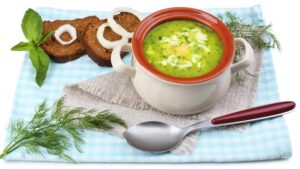Tomato soup is a popular soup made primarily from tomatoes, typically served hot, although it can be served cold as well. It is a versatile dish that can be prepared in various ways, offering a comforting and flavorful experience. Tomato soup pairs well with a variety of sides like grilled cheese sandwiches, garlic bread, or a simple salad. It’s a comforting and classic dish enjoyed by many across the world.

Why Tomato Soup?
Tomato soup holds a special place in the culinary world for several compelling reasons:
Versatility:
Tomato soup is incredibly versatile. It can be enjoyed on its own as a comforting meal, served as an appetizer, or used as a base for other recipes like pasta sauces, stews, or casseroles.
Ease of Preparation:
Making tomato soup is relatively simple and requires minimal ingredients. Its basic recipe involves tomatoes, aromatics, broth, and seasonings, making it accessible to cooks of all levels.
Nutritional Benefits:
Tomatoes are rich in vitamins, particularly vitamin C and potassium. They’re also a good source of antioxidants, notably lycopene, which has been linked to various health benefits, including reducing the risk of certain chronic diseases.
Comfort Food Appeal:
Tomato soup is often associated with feelings of warmth and comfort. It’s a classic comfort food that many people turn to on cold days or when feeling under the weather due to its soothing and familiar nature.
Culinary Creativity:
Despite its simplicity, tomato soup offers ample room for creativity. You can adjust the flavors by adding various herbs, spices, or ingredients like cream, roasted vegetables, or different types of broth to create a personalized version that suits individual tastes.
Cultural Significance:
Tomato soup holds cultural significance in many parts of the world. It’s a staple in various cuisines and has become an iconic dish in countries like the United States, where it’s often paired with grilled cheese sandwiches.
Timelessness:
Tomato soup has stood the test of time. It has been enjoyed for generations and continues to be a beloved dish worldwide, making it a timeless classic in the realm of comfort foods.
In summary, tomato soup’s appeal lies in its simplicity, adaptability, nutritional benefits, and the emotional comfort it provides, making it a favorite for many people across different cultures and age groups.
Pairing and Serving Ideas:
Pairing and serving tomato soup with complementary dishes can elevate the dining experience. Here are some ideas:

Grilled Cheese Sandwich:
A classic pairing, grilled cheese sandwiches dipped into warm tomato soup create a comforting and satisfying meal. Experiment with different cheeses and bread for variety.
Croutons or Breadsticks:
Serve homemade or store-bought croutons alongside the soup for added texture and crunch. Breadsticks or garlic bread are also excellent accompaniments.
Fresh Herb Garnish:
Sprinkle freshly chopped herbs like basil, parsley, or thyme on top of the soup just before serving. It adds a burst of freshness and aroma.

Salad:
Pair the soup with a light salad, such as a simple mixed green salad or a Caesar salad. It provides a contrast in flavors and textures.
Savory Pastries or Biscuits:
Serve flaky pastries like puff pastry twists, savory scones, or biscuits on the side. These can be dipped into the soup or enjoyed separately.
Roasted Vegetables:
Roast vegetables like carrots, bell peppers, or zucchini and serve them as a side dish. They add depth to the meal and complement the soup’s flavors.
Garlic Knots or Focaccia:
Freshly baked garlic knots or slices of herb-infused focaccia make excellent companions to tomato soup. The bread’s savory flavors complement the soup’s richness.

Meat or Protein Additions:
For a heartier meal, consider adding protein like shredded chicken, cooked bacon bits, or even grilled shrimp to the soup or serve it alongside.
Parmesan or Cheddar Crisps:
Bake grated Parmesan or cheddar cheese until crispy and use them as a garnish or a side dish. They offer a cheesy crunch that pairs wonderfully with the soup.
Stuffed Bread Bowls:
Hollow out small bread rolls or bowls and fill them with the soup. It’s a creative way to serve and eat the soup while enjoying the bread as well.
By incorporating these pairing and serving ideas, you can create a delightful and diverse dining experience around a simple bowl of tomato soup, catering to different tastes and preferences.
Tips for Storage and Reheating
Properly storing and reheating tomato soup helps maintain its flavor and texture. Here are some tips:
Storage Tips:
- Cooling Down: Allow the soup to cool to room temperature before storing. This prevents condensation and helps maintain its quality.
- Refrigeration: Transfer the cooled soup into airtight containers or resealable bags. Store it in the refrigerator for up to 3-4 days.
- Freezing: Tomato soup freezes well. Pour it into freezer-safe containers or heavy-duty freezer bags. Leave some space for expansion, seal tightly, and label with the date. It can be frozen for about 2-3 months.
- Individual Portions: Consider freezing the soup in individual portions for easy thawing and reheating.
Reheating Tips:
- Thawing Frozen Soup: Move the frozen soup to the refrigerator the night before to thaw gradually. Alternatively, thaw it in a microwave using the defrost setting or a bowl of cold water.
- Stovetop Reheating: For refrigerated soup, reheat it gently over medium heat in a pot, stirring occasionally to prevent sticking. Add a splash of broth or water if it’s too thick.
- Microwave Reheating: Use a microwave-safe bowl and heat the soup in intervals, stirring between each interval to ensure even heating. This helps prevent hot spots.
- Avoid Boiling: Be cautious not to boil the soup while reheating, as this can change its consistency and affect the flavor.
- Adjust Seasonings: Taste the reheated soup and adjust seasonings if necessary. Sometimes flavors can mellow or intensify during storage.
- Additions: If the soup thickens upon reheating, consider adding a little broth or water to reach the desired consistency.
Safety Tips:
- Always ensure that the soup reaches a safe internal temperature when reheating, especially if it has been stored in the refrigerator or freezer. It should reach a gentle simmer to ensure it’s thoroughly heated.
- Discard any leftover soup that has been left at room temperature for more than 2 hours to avoid the risk of bacterial contamination.
By following these storage and reheating tips, you can preserve the freshness of your tomato soup and enjoy it at its best, whether freshly made or reheated from storage.
Additional Content
! To enhance your blog post about tomato soup, consider incorporating additional engaging content to captivate your readers. Here are some ideas:
- History and Origin:
- Delve into the history of tomato soup, its origins, and its evolution over time. Share interesting anecdotes or historical facts related to this beloved dish.
- Health Benefits:
- Discuss in more detail the health benefits of tomatoes and how they contribute to a nutritious diet. Highlight the antioxidants, vitamins, and minerals present in tomatoes.
- Regional Variations:
- Explore different regional variations of tomato soup from around the world. Discuss how various cultures prepare and enjoy their own versions of this dish.
- Storytelling or Personal Anecdotes:
- Share personal stories, childhood memories, or experiences associated with tomato soup. Engaging storytelling can create a connection with your readers.
- Fun Facts and Trivia:
- Compile a list of fun facts, trivia, or little-known facts about tomatoes or tomato soup. For example, the tomato was once considered poisonous in some parts of Europe!
- Chef’s Tips and Tricks:
- Gather tips from chefs or culinary experts on how to elevate the flavor of tomato soup, unique ingredient combinations, or presentation techniques.
- Serving Suggestions from Readers:
- Encourage your readers to share their favorite serving suggestions or unique pairings for tomato soup. Feature some of these suggestions in your blog post.
- Seasonal Adaptations:
- Discuss how tomato soup can be adapted to different seasons. For instance, offer variations for a refreshing cold tomato soup perfect for summer.
- Nutritional Comparison:
- Compare homemade tomato soup with store-bought versions, highlighting the nutritional differences and the benefits of making it from scratch.
- Video Content:
- Consider creating a video alongside your blog post, demonstrating the step-by-step process of making tomato soup. Visual content can be engaging and helpful for readers.
- User-Generated Content:
- Encourage your audience to share their photos or experiences with your tomato soup recipe. Feature some of these user-generated content pieces in your blog post or on social media.
Recipe
! Here’s a simple and delicious recipe for homemade tomato soup:
Homemade Tomato Soup Recipe
Ingredients:
- 2-3 pounds fresh tomatoes, cored and roughly chopped
- 2 tablespoons olive oil
- 1 onion, chopped
- 3 garlic cloves, minced
- 4 cups vegetable or chicken broth
- 1 tablespoon sugar (optional, to balance acidity)
- Salt and pepper to taste
- 1 teaspoon dried basil (or 2-3 tablespoons fresh basil), plus extra for garnish
- 1/2 cup heavy cream (optional)
- Fresh parsley for garnish (optional)
Instructions:
- Sauté Aromatics: In a large pot or Dutch oven, heat the olive oil over medium heat. Add the chopped onion and sauté until translucent, about 3-4 minutes. Add the minced garlic and cook for an additional 1-2 minutes, stirring frequently.
- Add Tomatoes: Put the chopped tomatoes into the pot along with any juices. Stir and cook for about 5-7 minutes until the tomatoes start to break down.
- Simmer with Broth: Pour in the vegetable or chicken broth, covering the tomatoes. Season with salt, pepper, sugar (if using), and dried basil. Bring the mixture to a boil, then reduce the heat to low. Cover and simmer for about 20-25 minutes, allowing the flavors to meld together.
- Blend the Soup: Turn off the heat and let the soup cool slightly. Use an immersion blender directly in the pot or transfer the soup in batches to a blender. Blend until smooth. If you prefer a chunky texture, blend it less or leave some chunks of tomatoes.
- Adjust Consistency and Seasoning: Return the soup to the pot. If it’s too thick, add more broth or water to reach your desired consistency. Taste and adjust seasoning as needed.
- Add Cream (Optional): For a creamy texture, stir in the heavy cream. Heat the soup gently without boiling after adding the cream.
- Serve: Ladle the soup into bowls. Garnish with a sprinkle of fresh basil or parsley. Serve hot with your choice of bread, croutons, or alongside a grilled cheese sandwich.
This recipe yields a comforting and flavorful tomato soup that can be customized to suit your preferences. Enjoy the warmth and richness of homemade tomato soup!




